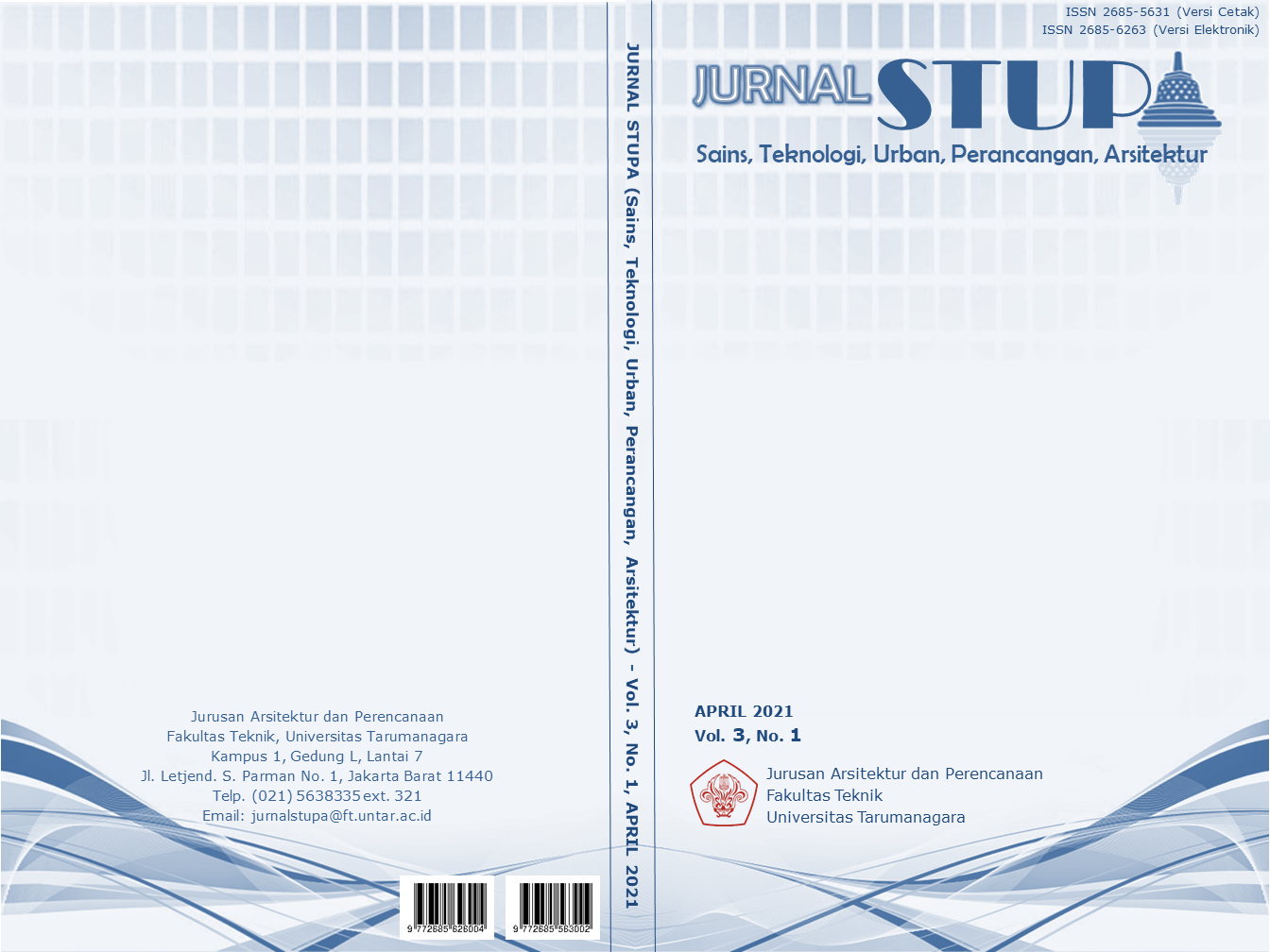STRATEGI PERANCANGAN DESAIN KERUANGAN HUNIAN VERTIKAL DI MASA PANDEMI COVID-19
Main Article Content
Abstract
The Covid-19 pandemic makes vertical housings vulnerable to mental health problems for residents. The cause of this problem is due to the small size of space, which is shrinking due to changes in urban patterns, which are not able to meet the needs of residents. The resident needs that are usually obtained outside the housing cannot be achieved due to social distancing or the lockdown. The closure of access also makes the residence must be able to become a place of work and entertainment space. As a result, the small dwellings are getting more and more cramped to live in. This problem encourages changes in new housing patterns that take into account the needs of each occupant. The use of a multidisciplinary approach by combining human psychology theory with architectural design theory is able to provide solutions in forming new residential patterns. Maslow's theory of human needs and Ray Oldenburg's theory of the Three Realms of Space form the basis of theory in designing. The design result is a residential unit module design that has all component place by Ray Oldenburg and fulfills Maslow's pyramid theory of needs.
Key words: Covid-19 pandemic; Housing Pattern; Human Needs; Shrinking Space; Three Realms of Space
Abstrak
Pandemi Covid-19 membuat hunian-hunian vertikal menjadi rentan terhadap permasalahan kesehatan mental penghuninya. Penyebab permasalahan ini dikarenakan ruang dengan ukuran kecil, yang menyusut akibat perubahan pola kota, yang tidak mampu memenuhi kebutuhan penghuni. Kebutuhan yang biasanya didapatkan di luar hunian menjadi tidak dapat dijangkau karena adanya social distancing hingga lockdown. Penutupan akses juga membuat hunian harus mampu beradaptasi menjadi tempat kerja dan tempat hiburan. Akibatnya hunian yang kecil semakin sesak untuk ditinggali. Permasalahan ini mendorong perubahan pola hunian baru yang mempertimbangkan kebutuhan masing-masing penghuni. Penggunaan metode pendekatan multidisiplin dengan menggabungkan teori psikologi manusia dengan teori desain arsitektural mampu memberikan solusi dalam membentuk pola hunian baru. Teori Maslow tentang kebutuhan manusia dan teori Ray Oldenburg tentang Three Realms of Space menjadi dasar teori dalam merancang. Hasil rancangan berupa desain modul unit hunian yang memiliki karakteristik ketiga tempat oleh Ray Oldenburg dan memenuhi teori piramida kebutuhan Maslow.
Article Details
References
Clapham, D. (2009). Introduction to the Special Issue – A Theory of Housing: Problems and Potential. Housing, Theory and Society, 26(1) 1-9, DOI: 10.1080/14036090802704445
Foye, C. (2017). The Relationship Between Size of Living Space and Subjective Well-Being. J Happiness Stud 18, 427–461. https://doi.org/10.1007/s10902-016-9732-2
Harjoko, Y. T., (2019) Dwelling dan Settling (Bertinggal dan Bermukim), diunduh 1 Januari 2021, https://uiarch.net/blog/bertinggal-dan-bermukim-sebuah-perenungan-eksistensial-arsitektur/
Heidegger, M. (1971). Building, Dwelling, Thinking. In A. Hofsdater (Ed.), Poetry, Language and Thought (pp. 143-162). New York: Harper & Row.
Maslow, A. H. (1943). A theory of human motivation. Psychological Revie., 50(4). pp.370–396.
McClintock, A. (2020). Coronavirus lockdown has magnified the pitfalls of living in a tiny house, dikutip 3 Januari 2021, https://www.abc.net.au/news/2020-04-01/tiny-apartment-life-during-the-coronavirus-lockdown/12084538
Norberg-Schulz, C. (1985). The concept of dwelling: on the way to figurative architecture. [Milan]: New York: Electa, Rizzoli.
Oldenburg, R. (1989). The Great Good Place: Cafes, Coffee Shops, Bookstores, Bars, Hair Salons, and Other Hangouts at the Heart of a Community. New York: Da Capo Press Books.
Olson, A. (2013). The Theory of Self-Actualization, diunduh 1 Januari 2021, https://www.psychologytoday.com/us/blog/theory-and-psychopathology/201308/the-theory-self-actualization
Reynolds, L. (2005). Full House? How overcrowded housing affects families. London: Shelter.
Roberts-Hughes. (2011). Space standard, The case for space the size of England’s new homes (pp.4-26). Royal Institute of British Architects.


